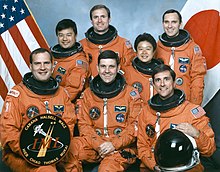STS-65

Spacelab in Columbia's payload bay
|
|||||
| Mission type | Microgravity research | ||||
|---|---|---|---|---|---|
| Operator | NASA | ||||
| COSPAR ID | 1994-039A | ||||
| SATCAT № | 23173 | ||||
| Mission duration | 14 days, 17 hours, 55 minutes | ||||
| Distance travelled | 9,886,200 kilometers (6,143,000 mi) | ||||
| Orbits completed | 235 | ||||
| Spacecraft properties | |||||
| Spacecraft | Space Shuttle Columbia | ||||
| Payload mass | 10,811 kilograms (23,834 lb) | ||||
| Crew | |||||
| Crew size | 7 | ||||
| Members |
Robert D. Cabana James D. Halsell Richard J. Hieb Carl E. Walz Leroy Chiao Donald A. Thomas Chiaki Naito-Mukai |
||||
| Start of mission | |||||
| Launch date | 8 July 1994, 16:43:01 UTC | ||||
| Launch site | Kennedy LC-39A | ||||
| End of mission | |||||
| Landing date | 23 July 1994, 10:38:01 UTC | ||||
| Landing site | Kennedy SLF Runway 33 | ||||
| Orbital parameters | |||||
| Reference system | Geocentric | ||||
| Regime | Low Earth | ||||
| Perigee | 300 kilometres (190 mi) | ||||
| Apogee | 304 kilometres (189 mi) | ||||
| Inclination | 28.45 degrees | ||||
| Period | 90.5 minutes | ||||
|
|
|||||


Left to right - Seated: Hieb, Cabana, Thomas; Standing: Chiao, Halsell, Naito-Mukai, Walz
STS-65 was a Space Shuttle program mission of Columbia launched from Kennedy Space Center, Florida, 8 July 1994. The flight was commanded by Robert D. Cabana who would go on later to lead the Kennedy Space Center.
The International Microgravity Laboratory (IML-2) was the second in a series of Spacelab (SL) flights designed to conduct research in a microgravity environment. The IML concept enabled a scientist to apply results from one mission to the next and to broaden the scope and variety of investigations between missions. Data from the IML missions contributed to the research base for the space station.
As the name implies, IML-2 was an international mission. Scientists from the European Space Agency (ESA), Canada, France, Germany and Japan collaborated with NASA on the IML-2 mission to provide the worldwide science community with a variety of complementary facilities and experiments. These facilities and experiments were mounted in twenty 19" racks in the IML 2 Module.
Research on IML-2 was dedicated to microgravity and life sciences. Microgravity science covers a broad range of activities from understanding the fundamental physics involved in material behavior to using those effects to generate materials that cannot otherwise be made in the gravitational environment of the Earth. In life sciences research, a reduction of gravitation's effect allows certain characteristics of cells and organisms to be studied in isolation. These reduced gravitational effects also pose poorly understood occupational health problems for space crews ranging from space adaptation syndrome to long-term hormonal changes. On IML-2, the microgravity science and life sciences experiments were complementary in their use of SL resources. Microgravity science tends to draw heavily on spacecraft power while life sciences places the greatest demand on crew time.
...
Wikipedia
